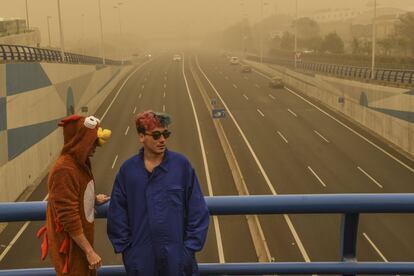Fires, sandstorms and blackouts: The ‘annus horribilis’ of Spain’s Canary Islands
From extreme weather events to the collapse of the Thomas Cook travel group, the archipelago has faced a number of crises in the past few months


Martín Esteban worked as a waiter in Madrid for 30 years. Then one day he left everything behind and went to live with his partner on the island of La Gomera, in Spain’s Canary Islands. Once there he found a calm he had never known before, a clean and clear sky, a life without noise, traffic lights or traffic jams. “I found my small piece of paradise,” says the 61-year-old.
But a week ago, he began to have breathing problems. It made him think of the heart attack he suffered a year ago, like a ghost reminding him of his mortality. Esteban leaned out on to the street and his face was hit by a sandy wind. If he had opened his mouth, he could have eaten sand. He couldn’t see more than a few meters ahead because a wall of orange sand was covering the horizon. The old fishermen on the island told him that sandstorms were nothing new to the island, but never before had one been so powerful.
“We were facing something extraordinary,” says Martín.
For the last eight months, the out-of-the-ordinary has become the new normal in the Canary Islands. The sandstorm at the end of February completely cut off the archipelago. For the first time in history, authorities closed all the airports in the Canary Islands. In some places, the wind reached 160 kilometers per hour. The records for high temperatures in February were broken. The sandstorm, however, was just one of the many problems to have struck the region, like Biblical plagues.
I have never seen anything like itVíctor, farmer from Tenerife
Before the sandstorm had even cleared, the island of Tenerife on Monday confirmed its second case of the Covid-19 coronavirus. The first case was reported a month ago after a German tourist tested positive for the virus in La Gomera. This time the patient was an Italian tourist who was staying at a luxury hotel in Adeje, in the south of Tenerife. The man, a doctor by trade, went to the hospital, suspecting that he had contracted the virus. In an effort to control the spread of the global epidemic, regional authorities decided to put the entire hotel in lockdown, isolating more than a thousand guests and staff. It was an unprecedented event in the history of tourism on the island: never before had such a large hotel been shut down.
The Canary Islands’ bad run began in August last year, when 20 days of uncontrolled fires swept across 8% of the island of Gran Canaria. Entire municipalities were evacuated, and the emergency military unit (UME) was forced to act.
“Everything has happened to us. And suddenly,” says an official from the emergency department of the Canary Island regional government. “A series of extraordinary cases have come together and made life much more difficult for us, without a doubt.”

A month after the fires, a power failure at an electricity substation left the entire island of Tenerife and its 900,000 residents in the dark. Store and house alarms rang nonstop. According to the emergency official, it was the “first time in a decade” that the island had suffered such a power outage. Police secured the city.
A second before the blackout, Manuel Nogales, the head of the Institute of Natural Products and Agrobiology at the Spanish National Research Council (IPNA-CSIC), was preparing a presentation on his computer. An alarm warned him that the refrigerators that stored important samples for investigations were heating up. “A huge amount of time invested by scientists could have been lost,” he says by phone. “One cooler, in particular, had material concerning rare diseases that we had worked on. It was a highly valuable product.” Nogales ran to the institute and found a maintenance worker. Between the two of them, they were able to get the backup generator to start. “It was a terrible fright,” he says.
Around the same time as the blackout, the British travel group Thomas Cook collapsed. The fall of the tourism giant left 313,000 flights scheduled to fly from the United Kingdom to the Canary Islands between October 2019 and August 2020 in limbo. The economic damage was huge.
A power failure left the entire island of Tenerife and its 900,000 residents without electricity
Not long after the collapse of Thomas Cook, there was another problem. A tanker truck carrying 3,000 liters of diesel fuel fell down a hill in Tacoronte in Tenerife, hitting a protected area of great ecological value. A special 300-ton crane was needed to remove the truck, and authorities had to disinfect the area.
It has been a disastrous year for the Canary Islands. The recent sandstorm brought with it hot and dry conditions, causing more wildfires on the islands of Gran Canaria and Tenerife. Farm workers in the Tenerife municipality of Santa Úrsula were forced to watch as their vineyards and some of their homes went up in flames.
“That’s the house where I grew up. That pink house,” says Víctor, a 47-year-old farmer, pointing to a burned structure. “This was like a tinderbox. The flames devoured us.”
“I have never seen anything like it,” he adds.
This has become a common phrase in the Canary Islands. Everything appears to have happened for the first time, or with more force than ever before. Some of the problems, however, have been resolved.
Two days after the sandstorm, the waiter Martín Esteban is enjoying the clear skies.
“Now there is a splendid and marvelous sky. It’s 24º Celsius.”
Asked whether La Gomera was once again his paradise, he replies: “Yes it is. I will stay here forever.”
English version by Melissa Kitson.
Tu suscripción se está usando en otro dispositivo
¿Quieres añadir otro usuario a tu suscripción?
Si continúas leyendo en este dispositivo, no se podrá leer en el otro.
FlechaTu suscripción se está usando en otro dispositivo y solo puedes acceder a EL PAÍS desde un dispositivo a la vez.
Si quieres compartir tu cuenta, cambia tu suscripción a la modalidad Premium, así podrás añadir otro usuario. Cada uno accederá con su propia cuenta de email, lo que os permitirá personalizar vuestra experiencia en EL PAÍS.
¿Tienes una suscripción de empresa? Accede aquí para contratar más cuentas.
En el caso de no saber quién está usando tu cuenta, te recomendamos cambiar tu contraseña aquí.
Si decides continuar compartiendo tu cuenta, este mensaje se mostrará en tu dispositivo y en el de la otra persona que está usando tu cuenta de forma indefinida, afectando a tu experiencia de lectura. Puedes consultar aquí los términos y condiciones de la suscripción digital.
More information

Nearly 1,000 tourists in isolation at a Spanish hotel after man tests positive for coronavirus
Últimas noticias
A survivor’s account of the Interoceanic Train accident: ‘We were scared because of the speed on the curve’
The Interoceanic Train, the Mexican alternative to the Panama Canal
What is known about the Interoceanic Train derailment in Oaxaca
Trump turns a Minnesota fraud allegation into ammunition for his MAGA army against Democrats
Most viewed
- Oona Chaplin: ‘I told James Cameron that I was living in a treehouse and starting a permaculture project with a friend’
- Reinhard Genzel, Nobel laureate in physics: ‘One-minute videos will never give you the truth’
- Why the price of coffee has skyrocketed: from Brazilian plantations to specialty coffee houses
- Pablo Escobar’s hippos: A serious environmental problem, 40 years on
- Chevy Chase, the beloved comedian who was a monster off camera: ‘Not everyone hated him, just the people who’ve worked with him’









































